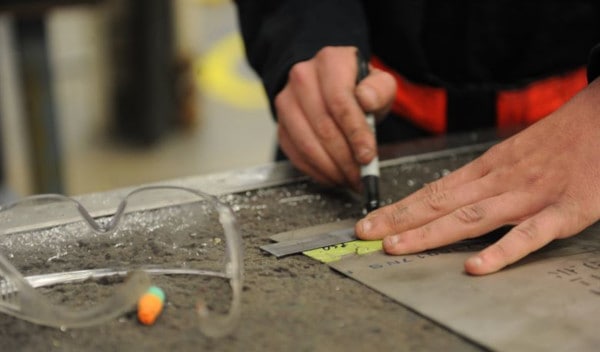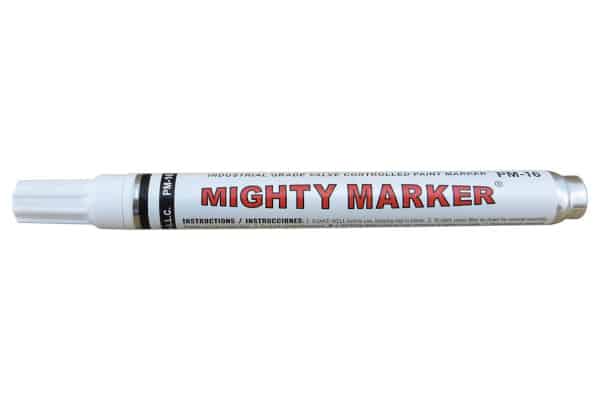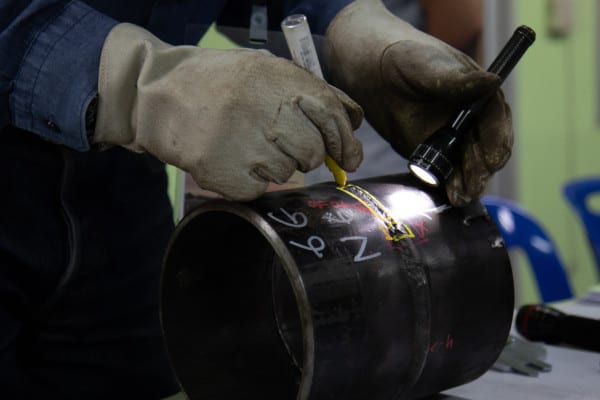Markers that leave clean, long-lasting lines are essential tools in the essential trades
Permanent markers seem to stick to everything: judging by just how many guides there are to getting the stuff out of fabric, skin, wood, and drywall, it seems like there’s nothing the world’s go-to tool for long-lasting marks can’t do. But in industrial applications and particularly for those working on non-porous surfaces, they can’t always deliver—paint markers are the tool you need.
In our first review of the humble yet incredibly useful paint marker, we look at some of those applications, explaining how oil-based paint markers for metal make life easier for those working in construction, metalwork, and other trades.
Paint markers vs. soapstone, permanent markers, welder’s pens, and wax pencils
Paint markers come in all shapes, sizes, colors, and types. From brand-names like Sharpie to general-use acrylic, glass, or oil-based versions, they leave permanent marks on surfaces that resist tagging with permanent markers. Their characteristics—and those of industrial paint markers in particular—vary enormously. Some are designed to wear off with soap, detergent, or water. Others will work on any non-porous surface, while still others are specifically tailored to a handful of industries or applications.

Typically, manufacturers and retailers list sizes for paint markers in millimeters. For reference, the tip of a ballpoint pen often ranges from 0.7 millimeters for fine-tip pens to 1 millimeter for medium-tip pens.
The average permanent marker might have a 1-millimeter tip—even though it leaves broader marks—while chisel-tip highlighters used to markup text might be in the neighborhood of 4 to 8 millimeters. When it comes to paint markers, a 1/8-inch (roughly 3-millimeter) tip may do well in most applications, but 1/16-inch (1.5 mm) nibs will help in making fine marks or marks in tight spaces or corners.
There’s a paint marker for almost any marking task, though not every job calls for one. For example:
- Soapstone, a chalk-like substance, does well when removable marks are needed in a variety of sizes.
- Permanent markers may clog when used on oily or dusty surfaces, but they come in handy when drawing broad lines on porous surfaces.
- Both welder’s pens and wax pencils can leave sharp lines suitable for short-term use—and welder’s pens can make cutting marks particularly easy to see while using a plasma cutter.
But paint markers’ ability to deliver long-lasting marks on all kinds of porous and non-porous surfaces makes them a suitable complement, if not a general-purpose substitute, for many industrial writing tools.
Paint markers for metal vary in their resistance to heat and ability to bind through oils, water, and other liquids
The marking material inside paint markers consists of three main components: pigment, solvent, and resin. Solvent keeps the paint in a liquid state inside the marker. Pigment gives color to the marks, of course, while resin binds the paint to the surface. Tip types can make a sizable difference in how these elements look when applied. Paint markers for metal may feature polyester nibs, which tend to hold their shape over time, or acrylic nibs, which do well on rough surfaces.
Each of these elements deserves a close look. Pigments may be bright on some metals and dull on others. Some resins break down at temperatures as low as 150 degrees Fahrenheit, while others can withstand temperatures exceeding 1,800 degrees. If the marks will eventually require removal, users must consider what, if anything, can quickly get rid of those marks: water, window cleaner, detergent, or specific solvents may be required depending on the resin used.
Similarly, the type of resin used also dictates how likely those marks are to survive while working on or around the metal’s surface. When the metal is coated with rust-inhibiting oil, oleophobic-formulated paint can push oils out of the way, allowing the resin to bond with the surface. Other paint markers for metal use hydrophobic-formulated paint, which can dry through water or other liquids used in plasma cutting and other machining applications.
Oil-based paint markers for metal provide long-lasting marks used for identifying components, making cuts, and other routine tasks in the construction trades
When it comes to construction work, both permanent markers and paint markers have their place. Permanent markers tend to dry faster but fade when exposed to sunlight or solvents. Thus, paint markers and paint pens perform well in the long-term while “permanent” markers, ironically, do well in the short-term.
In heating, ventilation, and air conditioning (HVAC) work, reference marks written inside a panel can help identify which belt or filter belongs in a particular air conditioning unit. Paint markers are ideal for permanently marking the locations of breakers or rooftop controls, making follow-up visits to the job site that much easier. They also make it easy to indicate when specific components are out of service and need repair.

They also come in handy in other aspects of building construction and maintenance. While carpenter’s pencils and lumber crayons are go-to tools for framing, oil-based paint markers help construction workers of all kinds initial their tools or mark shingles for cutting. Welding inspectors even use them to mark steel during construction, signing off on welds to indicate that they’re structurally sound.
Welders and machinists make marks for cutting, quality assurance, and more
Machinists sometimes struggle to find a paint marker, paint pen, or another so-called industrial marking tool that actually works.
It’s important for marks in these environments to be highly visible and they must withstand the sort of work involved. The difficulties stem from the sheer variety of tools and materials used: hot-rolled metal, black DELRIN-brand rod, and other dark or matte pipes can make most marks difficult to see. Hot, oily surfaces respond well to certain markers and not others. And while some types of work require very fine marks, others require broader strokes that remain in sight throughout the course of the job.

Some tips for using markers in machining and welding:
- While chalk or soapstone may be up to the job, paint markers for metal come in handy when marks will be chafed, moved, cut, left outdoors, or exposed to chemicals.
- Most markers can easily produce large lines, but many are too broad for layout marks guiding precision cuts. For small parts, and in more detailed applications, fine-tipped paint markers and even paint pens come in handy.
- When marking metals that are coated in oil, markers will perform better if the paint contains a bit of solvent—such as the Xylene-based markers offered by Arro-Mark and other manufacturers—to prevent bleeding.
- As in other industries, marking parts is standard practice in machining. In those cases, it’s important to leave fine, truly permanent marks that withstand solvents and even a variety of abrasive wear. Oil-based paint markers can leave high-visibility marks that make it easy to inscribe the alloy or material designations—that is, the specific type of metal or material—on the metal’s surface.
Quality markers work in difficult environments
Like permanent markers, paint markers aren’t a catch-all: there’s an abundance of marking tools on the market, and for good reason. But unlike “permanent” markers, paint markers for metal really are designed to be permanent in industrial settings, giving fabricators, construction workers, and others an edge in tasks ranging from labeling to welding.
Arro-Mark Company, a family-owned business in Englewood, New Jersey, specializes in the manufacture of industrial marking devices. With a product line consisting of more than 100 marker types, Arro-Mark’s expertise is on display in environments ranging from automotive manufacturing to nuclear power plants.
QRFS is proud to carry a selection of Arro-Mark’s MIGHTY MARKER-brand paint markers for metal in eleven colors, including:
Each of Arro-Mark’s PM-16 MIGHTY MARKER features an opaque, oil-based paint with Xylene that writes on metal, rubber, plastic, glass, concrete, and a host of other surfaces. Their paint can last as long as ten years on outdoor surfaces—and marks dry in 30 seconds or less.

Each of these oil-based paint markers features 10 milliliters of paint and a 2.3-millimeter bullet tip—roughly half the width of a highlighter or twice the width of most fine-tipped markers. MIGHTY MARKER paint markers for metal are valve-activated, filling the marker nib with a quick shake.
Check out our selection of oil-based paint markers for metal and other surfaces.
Questions about paint markers for metal or oil-based paint markers in general? Call us at +1 (888) 361-6662 or email support@qrfs.com.
This blog was originally posted at blog.qrfs.com. If this article helped you learn a little bit more about these underappreciated industrial marking tools, check us out at Facebook.com/QuickResponseFireSupply or on Twitter @QuickResponseFS.



This is really amazing content and I’m very happy to read this amazing content.
For metal, I use Sharpie Oil-Based paint marker. I always think the best pen to write on metal are the ones with an oil base because they do not wipe off or fade easily. They stay on the surface of the metal almost permanently or until such a time that you want to remove them.